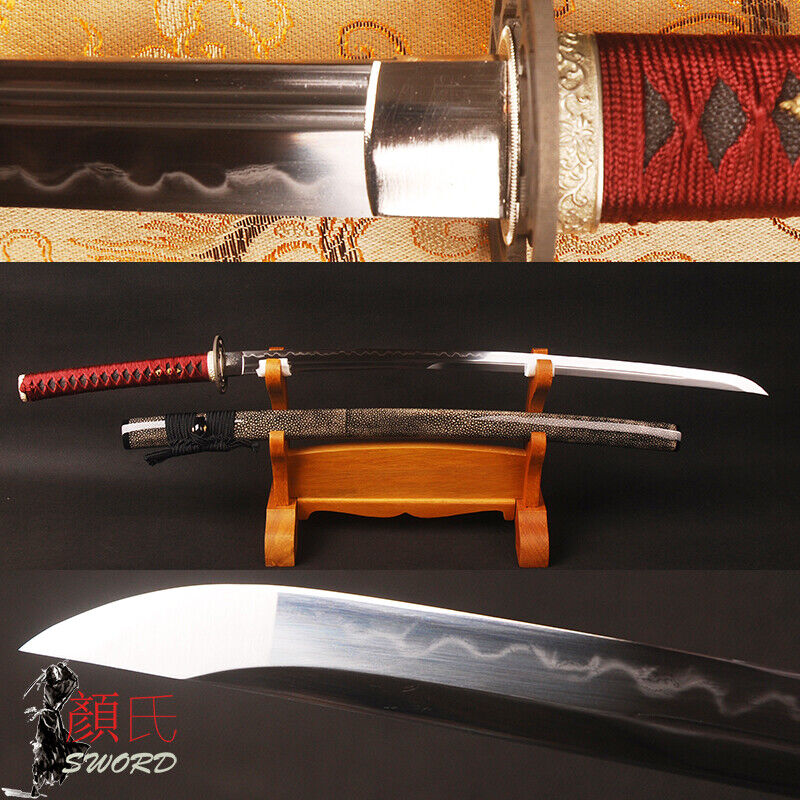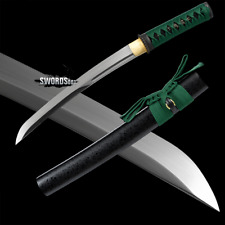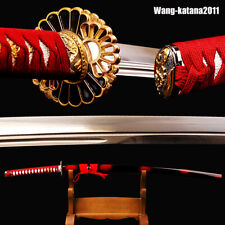

|
Site Categories |

|
Featured Items |

Poodle, Spaghetti Trim, Ucagco


|
Unokubitsukuri 1095 Carbon Steel Japanese Samurai Katana Clay Tempered Full Tang For Sale


When you click on links to various merchants on this site and make a purchase, this can result in this site earning a commission. Affiliate programs and affiliations include, but are not limited to, the eBay Partner Network.

Unokubitsukuri 1095 Carbon Steel Japanese Samurai Katana Clay Tempered Full Tang:
$405.00
- This katana can be taken apart fully at anytime for maintenance purposes, you can disassemble the sword by taking out the pegs from the handle.GENERAL DATAOVERALL LENGTH:103 cm / 40.6 inchBLADE LENGTH:70 cm / 27.6 inchTSUKA LENGTH:26 cm / 10.24 inchBLADE WIDTH:3.2 cm / 1.26inchBLADE THICKNESS:0.7 cm / 0.28inchBLADE HRC:58BLADE CRAFTBLADE CRAFT:fully hand forged, hand polished,clay hardened, water quenchingBLADEMATERIAL:1095 carbon steelBLADE SHAPE:UnokubitsukuriNAKAGO:full tangHAMON:real hamon, clay hardened lineSHARPNESS:★★★★★MIRROR wood core,hinerimakiMEKUGI:2 bamboo pegsTSUKA-ITO:bright wine red synthetic silk cordSAMEGAWA:genuine white rayskinFUCHI / KASHIRA:morning glory pattern, silver-plated brassMENUKI:morning glory pattern, brassTSUBA(HAND GUARD): ironSEPPA:high quality brassHABAKi:electroplated silvery brassSAYA:full wrapped rayskin scabbard with buffalo horn fittings, black specialized sageoPACKAGE1 sword with saya1 black cotton bagNOTICESword display holder(stand) is not includedManual measurement error range 1-2 cm
Clay HardeningBefore being quenched, a special clay mixture can be applied onto the blade to harden the edge and obtain different hardness on the blade. The clay mixture was a special recipe and considered a crucial trade secret, guarded protectively by sword making masters. It would contain such things as feathers, powdered bones, grass, etc. and would be applied to the edge of the blade before being quenched. During quenching, a chemical reaction between the clay mixture and the hot steel occurs during the sudden temperature drop and carbon is fed into the blade in high amounts, creating an extremely tough edge. A clay hardened blade can only bequenched in water, thus increasing the defect rate even more.
FormingSwords can be shaped by a variety of metalworking techniques.The primary techniques are forging and stock removal.
Forging uses heat to bring the material to a malleable state. The material is then hammered to shape, typically using hammer and anvil together with specialized set and fuller tools depending on the particular technique.
Stock removal shapes the sword from prepared stock that is larger in all dimensions than the finished sword by filing, grinding and cutting.
Quenching After the blade has been shaped, the sword would be quenched. We quench our swords in either water or oil. Water quenching produces a tougher edge which can also be hardened further more using clay. Blades quenched in oil are still considerably hardened and do have superior flexibility compared to a water quenched blade.
The more rapidly a blade cools down, the harder it becomes. Thus, when a hot blade enters the water, the water also gains heat and the blade will cool more gradually. Therefore, the first part of the blade that enters the water will be the hardest. Therefore, the technique of quenching was also very important. If a blade has any flaws from forging (air bubbles, ash), it will break immediately during the quenching process.
Tempering
After quenching, the sword will be quite tough and brittle, with little flexibility. To overcome this, the blade would undergo a tempering process. The blade would be reheated to a certain temperature degree then allowed to cool naturally. The blade would be slightly less tough afterward but have a greater degree of flexibility – the art would be to perfectly balance the blade for toughness, sharpness and flexibility.
Modifying Shape
Finishing
Finishing encompasses polishing, decorating, and crafting and assembling the hilt, guard and sheath.
The swordsmith would be most concerned with the state of the blade itself and possibly decorating the blade and preparing the guards and pommel. Other artisans would likely be involved in the work of fashioning the hilt, sheath and other furniture; and in any fine decoration. Polishing When the rough blade is completed, the swordsmith turns the blade over to a polisher, whose job it is to refine the shape of a blade and improve its aesthetic value. The polishing process almost always takes longer than even crafting, and a good polish can greatly improve the beauty of a blade, while a bad one can ruin the best of blades. Early polishers used three types of stone, whereas a modern polisher generally uses seven.On high quality blades, only the back of the blade and the adjacent sides, are polished to a mirror-like surface. To bring out the grain and hamon, the center portion of the blade, and the edge are usually given a matte finish. Microscopic scratches in the surface vary, depending on hardness. Smaller but more numerous scratches in the harder areas reflect light differently from the deeper, longer scratches in the softer areas. The harder metal appears more matte than the softer, and the manner in which it scatters light is less affected by the direction of the lighting.
After the blade is finished it is passed on to a mountings-maker for fashioning the hilt, sheath and other mountings. NOTICEInternational Buyers – Please Note:a) Import duties, taxes and charges are not included in the item price or shipping charges. These charges are the buyer’s responsibility.b) Please check with your country’s customs office to determine what these additional costs will be prior to offerding/buying.DELIVERY DETAILSThe shipment will be prepared and get shipment as soon as possible when you place the order. The shipping time is different according to the different area.
US: 10-15 days
AU: 8-12 days
Ca: 10-15 days
Others: 25-60 days
It is international shipment, so there are many factors influenced, please let us know if there is any question, we will try our best to make things right for you.

|
|
Related Items:
21'' Self-defense Tanto 1095 Steel Japanese Unokubitsukuri Short Swords Knife $120.00

Unokubitsukuri 1095 Carbon Steel Japanese Samurai Katana Clay Tempered Full Tang $405.00

Unokubitsukuri Katana T1095 Sharp Battle Ready Japanese Samurai Functional Sword $150.00
|
|


|
Shopping Cart  |

|
Recently Viewed |

|
Latest Items |

|
Facebook |
Secure Websites

|








